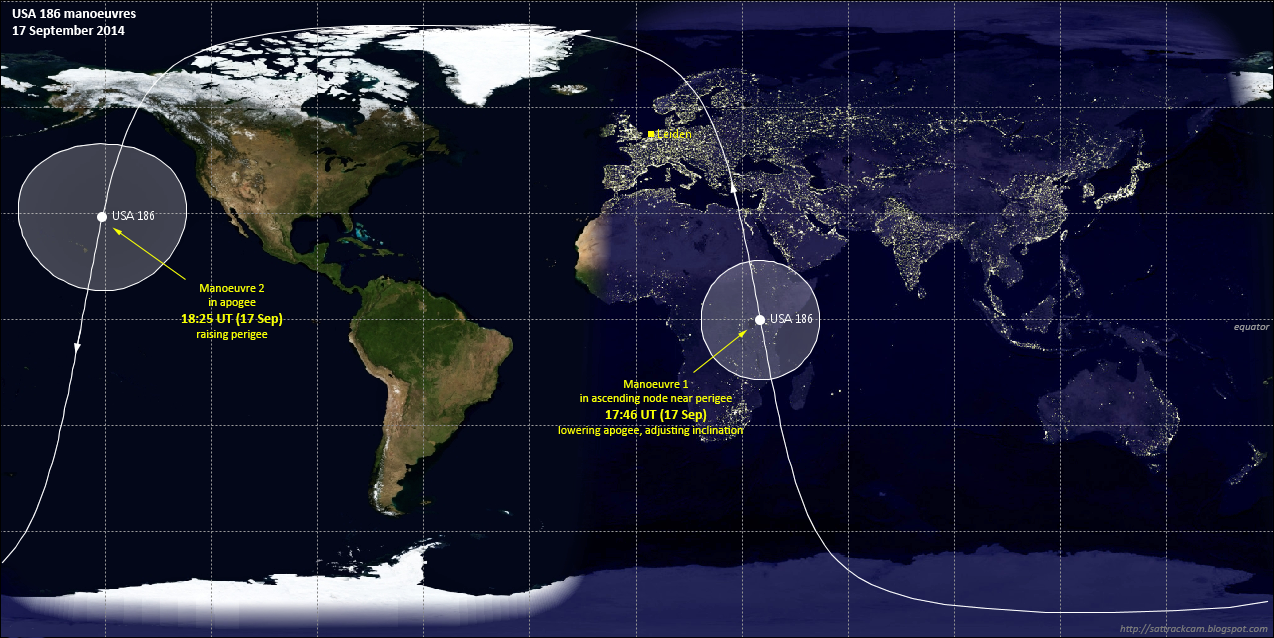 | ||
USA 186 being half a minute late one hour after the manoeuvre, 17 Sept 2014, 19:32:02 UT. Chinese satellite Yaogan 11 also visible (click image to enlarge)
|
Ten days after the first post-summer-glareout observations of the KH-11 Keyhole/CRYSTAL optical reconnaissance satellite USA 186 (2005-042A), it has made another orbital manoeuvre.
In the evening of Wednesday 17 September I was targetting the satellite in a somewhat hazy sky, using the 1.4/85mm lens and a FOV near the tip of the Big Dipper tail.
To my surprise, the satellite was over half a minute late with respect to a 3-day-old element set. This suggested a manoeuvre. My observations were corroborated by video observations of Leo Barhorst in the Netherlands and visual observations by Pierre Neirinck in France, obtained during the same pass.
The image above shows one of my images. As it turns out, this image was taken perhaps only an hour after the manoeuvre! USA 186 is overtaking Yaogan 11 (2010-047A) in the image (the fainter shorter, upper trail). Yaogan 11 is a Chinese optical reconnaissance satellite.
Observations the following evening by Cees Bassa and me in the Netherlands showed the satellite running even more late by that time: it passed 6m 32s late, low in the west. My camera caught it very close to the image edge. A few hours later, Kevin Fetter in Canada captured it as well.
The Sept 17 and 18 observations suggest that the manoeuvre happened on Sept 17, just before I did my Sept 17 observations (perhaps only an hour before, i.e. less than one revolution!). The current orbital solutions vary a bit between analysts (the post-manoeuvre observational arc is still short), but they agree in that the manoeuvre slightly adjusted the inclination, raised perigee and lowered apogee.
The new orbit is sun-synchronous and close to a 321 x 417 km orbit (it was 265 x 440 km before the manoeuvre), i.e. perigee was raised by about 55 km and apogee lowered by about 23 km. The new orbit is more circular, and starts to conform to the orbit I envisioned in October 2013. I suspect more manoeuvres gently raising perigee and lowering apogee until an approximate 390 x 400 km orbit is reached will occur over the coming half year.
An analysis using COLA suggests the manoeuvre(s) occured on 17 September, either near 17:46 UT or 18:25 UT. Or perhaps (and I favour that) it was a double manoeuvre, performed near both of these moments.
17:46 UT corresponds to passage through the ascending node on the equator, only minutes after passing through perigee. 18:25 UT corresponds to passing through apogee.
A manoeuvre to change inclination is normally done in one of the orbital nodes, or near the poles. A manoeuvre to raise or lower perigee is normally done while the satellite passes through it's apogee, and a manoeuvre to raise or lower apogee is normally done in the perigee. If either one of these (in the current case: the perigee) closely coincides with passage through one of the nodes, this is the ideal moment to change both peri- or apogee, and the inclination in one boost, which spares fuel.
It is very difficult to adjust the inclination, change the apogee altitude and change the perigee altitude in one manoeuvre.
My favoured scenario is therefore that a first manoeuvre happened near 17:46 UTC in or near the ascending node (and near perigee). This lowered the apogee altitude from 440 to 417 km, and allowed a slight adjustment of the inclination at the same time. Half a revolution later, while passing through apogee near 18:25 UTC, a second manoeuvre was made to raise the perigee altitude from 265 to 321 km.
 |
| (click map to enlarge) |
No comments:
Post a Comment